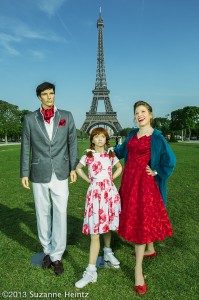The Mannequins in Our Lives
By Sara Esther Crispe: March 10, 2014: Category Inspirations, Thought Figures
Lessons from the Art Project “Life Once Removed”
 There is a powerful concept in Chassidic philosophy that when something is bothering us in another person, we are often looking in the mirror.
There is a powerful concept in Chassidic philosophy that when something is bothering us in another person, we are often looking in the mirror.
Perhaps that is why so many are having such strong reactions to the unique art project of Suzanne Heintz, “Life Once Removed.” She describes her project as, “A personal photography project about what is essentially…Spinsterhood, and the American Way.” I noticed her work when in my news feed it kept getting reposted with comments such as “sad,” “disturbing,” “What a lonely life…” and the such.
I was curious as to why she did what she did and how perhaps it wasn’t so much a reflection of what she lacked but what maybe the rest of us do.
The idea behind the project stemmed from her getting sick and tired of repeatedly being asked why she wasn’t married. As far as those around her were concerned, her purpose and meaning would only come to fruition with a ring on her finger. Actually, a ring on her finger and a baby in her belly.
If only she could “buy” a family to stop them from talking and make them happy…and one day she realized could. Passing a store with a mannequin family for sale, she made the purchase and thus began her photography project of her life with her fake family.
Now here is a woman who has either chosen not to get married or perhaps has not met someone that she wants to marry. I don’t know her so I can’t say. And it doesn’t matter. Her life decisions are not for me to comment upon.
But her project…spending years traveling, moving, propping up and photographing mannequins posed as her family. Is that something I can relate to? Learn from? Absolutely!
It is easy to look at this woman and find what she is doing as pathetic and a reflection of a lonely woman who has no one to share her life with. But to me what she is doing is pointing out to those of us with families how often we turn them into mannequins, posing them or with them for how others will perceive us, rather than truly connecting with those that we are connected to.
As she remarks on her project, “We love and obey the formatted image of a well-lived life. So deeply ingrained is that strange auto-grin we put on when a camera is present. Do we live our lives with a keen awareness of how it feels, or just how it looks?”
How absolutely true. How many of us only take pictures for the sole purpose of posting them on Facebook or Instagram? How often do we determine value by the comments others have about our activities or situations as opposed to the reactions of those who were actually involved in them?
For Heintz it is clear that her family is not real. That her situations are not real. That her happiness that she captures in her images is created for the sake of the picture. The sad part is when we do that to and with our loved ones.
Life isn’t what happens when we take the picture but rather when we put the camera away. Life is how we are and who we are when we think no one is looking.
Ironically I think Heintz is genuinely happier and authentically enjoying the process of taking her pictures with her fake family than so many of us feel when we create the set up for our real ones. Sure, we smile for the camera but often that smile is not reflective of what is happening. If anything, I can recall endless times I make my children stop the real fun they are having to pose for a picture where we look like we are having fun but we aren’t. The true fun wouldn’t have looked as good. So we try to recreate it for the camera. How sad is that?
It is uncomfortable to look at her image series but specifically because of how relatable it is. Specifically because it is too familiar. Too much like looking in the mirror.
 But unlike Heintz’s “family,” those of us with spouses and children can break beyond the externals. It might not look as good or be as fun but the result will be real. And to do that we need to stop worrying how we look and start focusing on how and who we are. We need to dig deep and tap into our core essence. And when we do, that is when we won’t need to fake our smiles or our happiness because any angle the picture is taken will reflect it. Or even more so, we won’t need the picture because we will have it in our hearts and minds.
But unlike Heintz’s “family,” those of us with spouses and children can break beyond the externals. It might not look as good or be as fun but the result will be real. And to do that we need to stop worrying how we look and start focusing on how and who we are. We need to dig deep and tap into our core essence. And when we do, that is when we won’t need to fake our smiles or our happiness because any angle the picture is taken will reflect it. Or even more so, we won’t need the picture because we will have it in our hearts and minds.
Heintz captures the external in her images. The face. In Hebrew that is called the panim. But in Hebrew the word for face shares the same root as the word for one’s internal, one’s pnimiyut. When we work from the inside out, the outside then can reflect the inside. We will be more than a face. We will be a soul that shines on our face. And we are then more likely to see more than a face when looking at another. For when we look past their external and tap into their soul, we do not feel the need to judge or impress or be fake, but rather we see just how much we have in common, just how much we can learn from one another, and just how many opportunities we always have to grow, develop and connect.
The Mannequins in Our Lives,

















;)
;)
;)
;)
;)
;)
;)
;)
;)
;)

So glad that someone else could understand what she was doing! I thought it was a brilliant commentary on relationships & society’s expectations. Very reflective of what we do every day trying to “show” the world what we think is our “best” selves.
Sara, this is the Artist, Suzanne Heintz. I just read what you wrote. I was asked to collect all of the articles that have been written about me. So, months after you wrote this, I finally can breathe a huge sigh of relief that SOMEone actually understood what I was trying to do.
I can’t tell you how painful it’s been to read all of the hurtful small-minded comments of others who have stolen my photos only to mock them as they use my content for free.
I must personally thank you for taking the time to look, think, and feel, then share the truth about my work’s intention, and to raise the bar even higher by asking better from people. I am so glad my story reached you. I can only wish that your intelligent observations and commentary could reach all of those who misunderstood my work.
Thank you. Please continue to share your mind and feelings with the world. It needs people like you.
Kindest Regards,
Suzanne Heintz
Conceptual Photographer
suzanneheintz.com